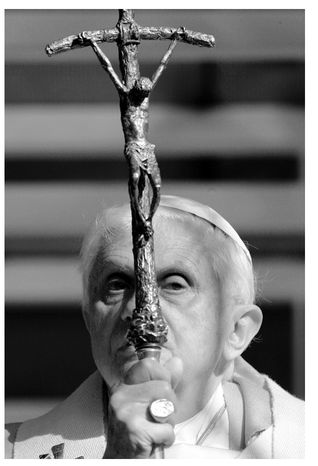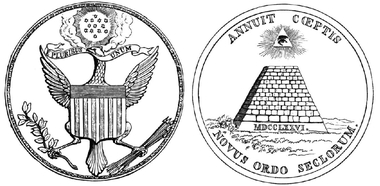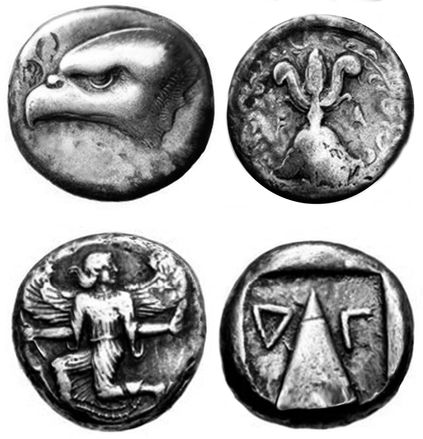The Source Field Investigations (8 page)
Read The Source Field Investigations Online
Authors: David Wilcock

We’ll come back to these startling Catholic examples in a minute. In
The 2012 Enigma,
I also pointed out that King Tut’s golden burial mask features a
uraeus,
or “kundalini serpent,” emerging from the general area of the pineal gland in his forehead. Statues of Buddha often feature a prominent third eye between his eyebrows as a raised, circular area. Buddha’s hair appears to be stylized in the shape of a pineal gland as well. Almost all Hindu gods and goddesses are pictured with a
bindi
, or third eye, between their eyebrows. Many Hindus still wear such a symbol to this day. The Hindu god Shiva’s hair also looks like a stylized pineal gland—and the “kundalini serpents” wrap around his neck.
5
The 2012 Enigma,
I also pointed out that King Tut’s golden burial mask features a
uraeus,
or “kundalini serpent,” emerging from the general area of the pineal gland in his forehead. Statues of Buddha often feature a prominent third eye between his eyebrows as a raised, circular area. Buddha’s hair appears to be stylized in the shape of a pineal gland as well. Almost all Hindu gods and goddesses are pictured with a
bindi
, or third eye, between their eyebrows. Many Hindus still wear such a symbol to this day. The Hindu god Shiva’s hair also looks like a stylized pineal gland—and the “kundalini serpents” wrap around his neck.
5

Pope Benedict XVI holding papal staff with carved pinecone—apparently symbolizing his ability to contact higher intelligence via the pineal gland.
After I released
The 2012 Enigma,
I found a sculpture of the Mesoamerican god Quetzalcoatl emerging from the mouth of a serpent—and the body of the serpent is coiled into the exact shape of the pineal gland. In this same sculpture, Quetzalcoatl wears a necklace made out of pinecones.
6
7
Better yet, the pinecones appear to have energetic waves streaming into them from the bottom. The mouth of the serpent frames Quetzalcoatl’s face just like we would see in a modern astronaut’s helmet. Also, if you look at pictures of the Temple of Quetzalcoatl, the “Plumed Serpent,” at Teotihuacan, you can easily see multiple images of pinecones carved alongside the serpent heads.
8
The 2012 Enigma,
I found a sculpture of the Mesoamerican god Quetzalcoatl emerging from the mouth of a serpent—and the body of the serpent is coiled into the exact shape of the pineal gland. In this same sculpture, Quetzalcoatl wears a necklace made out of pinecones.
6
7
Better yet, the pinecones appear to have energetic waves streaming into them from the bottom. The mouth of the serpent frames Quetzalcoatl’s face just like we would see in a modern astronaut’s helmet. Also, if you look at pictures of the Temple of Quetzalcoatl, the “Plumed Serpent,” at Teotihuacan, you can easily see multiple images of pinecones carved alongside the serpent heads.
8
Statue of Quetzalcoatl emerging from serpent’s mouth and wearing a wreath of pinecone-shaped objects. The entire statue is shaped like the pineal gland.

Ancient cultures also used sacred stones to symbolize the pineal gland. The Sumerian version was called the “Primitive Mountain”—and it was believed to be the first piece of land to emerge from the primordial sea during the foundation of Heaven and earth. This may represent how the pineal gland is allegedly the first place in the body that is contacted by the waters of Spirit—the nonphysical realms of the afterlife. In Babylonian culture, this same mountain became a symbol for the
axis mundi—
the axis the world turns on, and/or the central navel of the earth. This was the place where the gods came and went—and it was illustrated with the king standing directly on top of the mountain. A physical stone was also erected to mark this most sacred location—and it determined all the parallels and meridians, as well as the cardinal points of the compass.
9
axis mundi—
the axis the world turns on, and/or the central navel of the earth. This was the place where the gods came and went—and it was illustrated with the king standing directly on top of the mountain. A physical stone was also erected to mark this most sacred location—and it determined all the parallels and meridians, as well as the cardinal points of the compass.
9
The Egyptians had the same myth of a stone marking the center of the world, which they called the Benben—and the king Atum stood upon it during his act of creation. Some forms of the Benben are shaped exactly like the pineal gland. The capstone of a pyramid, as well as the pyramid structure itself, is also believed to represent the Benben stone.
10
This obviously gives incredible new context to the Great Seal of the United States. Here we have a single eye in a triangle, floating on top of a pyramid. In light of the pyramid/Benben/third-eye relationship, the symbolic connection between the Great Seal and the pineal gland is undeniable—and we will discuss this mysterious symbol in chapter 7. In early illustrations of the Great Seal of the United States, the bird on the front side was not an eagle—it was deliberately illustrated as a phoenix.
10
This obviously gives incredible new context to the Great Seal of the United States. Here we have a single eye in a triangle, floating on top of a pyramid. In light of the pyramid/Benben/third-eye relationship, the symbolic connection between the Great Seal and the pineal gland is undeniable—and we will discuss this mysterious symbol in chapter 7. In early illustrations of the Great Seal of the United States, the bird on the front side was not an eagle—it was deliberately illustrated as a phoenix.
The Egyptians drew the Benben stone with a bird flanking it on either side—called the Bennu bird.
11
This bird may be depicted as a hawk, eagle, heron or yellow wagtail, depending upon which Egyptian source you study—but in Greek mythology the Bennu bird is known as the phoenix.
12
This mythical creature experiences death by fire, followed by a spontaneous rebirth from the ashes—clearly associating the Bennu bird with a profound spiritual awakening and transformation. The words
Benben
and
Bennu
are both derived from the root syllable
Bn
, which means “ascension” or “to rise” in Egyptian.
13
Two serpents may also be pictured with the Benben stone, at times, and they appear equivalent to the “kundalini serpents” in Hinduism—illustrating the flow of energetic currents moving up the spine and on into the pineal gland.
11
This bird may be depicted as a hawk, eagle, heron or yellow wagtail, depending upon which Egyptian source you study—but in Greek mythology the Bennu bird is known as the phoenix.
12
This mythical creature experiences death by fire, followed by a spontaneous rebirth from the ashes—clearly associating the Bennu bird with a profound spiritual awakening and transformation. The words
Benben
and
Bennu
are both derived from the root syllable
Bn
, which means “ascension” or “to rise” in Egyptian.
13
Two serpents may also be pictured with the Benben stone, at times, and they appear equivalent to the “kundalini serpents” in Hinduism—illustrating the flow of energetic currents moving up the spine and on into the pineal gland.

Early concept art for Great Seal of the United States, c. 1776–1782. The bird is a stylized phoenix, and bears no resemblance to an eagle.
It is also fascinating to note that in Egyptian mythology, the Bennu’s cry is believed to have started the great cycles of time. These cycles were said to have been appointed by a Divine intelligence—and Horus, the Bennu bird, became the Egyptian deity associated with the division of time.
14
There is a strong possibility that the main unit of time represented by the Bennu’s cry is the Precession of the Equinoxes—a 25,920-year cycle that appears as a slow wobble in the earth’s axis. This strongly implied association between the Bennu and the 25,920-year cycle may be a prophecy that humanity will experience a phoenix-like transmutation effect at the end of this cycle—and we will explore other prophetic traditions that support this concept as well. (Our investigation into the precession begins in chapter 6.) The Egyptian Book of the Dead features instructions on how the spiritual seeker may transform himself or herself into a Bennu bird or phoenix, symbolically speaking—and the results of this practice, if successfully achieved, are very interesting:
14
There is a strong possibility that the main unit of time represented by the Bennu’s cry is the Precession of the Equinoxes—a 25,920-year cycle that appears as a slow wobble in the earth’s axis. This strongly implied association between the Bennu and the 25,920-year cycle may be a prophecy that humanity will experience a phoenix-like transmutation effect at the end of this cycle—and we will explore other prophetic traditions that support this concept as well. (Our investigation into the precession begins in chapter 6.) The Egyptian Book of the Dead features instructions on how the spiritual seeker may transform himself or herself into a Bennu bird or phoenix, symbolically speaking—and the results of this practice, if successfully achieved, are very interesting:
I have flown up like the primeval ones . . . I appear in glory with the strides of the gods. . . . As for him who knows this pure spell, it means going out into the day after death and being transformed at will. . . . And nothing evil shall have power over him.
15
15
In Hinduism the Shiva lingam is a stone shaped exactly like the pineal gland—and is mythologically associated with the center of the world, from which the god Shiva first burst through in a fiery spectacle.
16
Again we remember the pineal gland is in the geometric center of the brain, and was believed to be the first point of contact for telepathic information exchange—not unlike the idea of a god bursting through to communicate a message. Let’s not forget that Shiva is also drawn with the fully opened third eye, the kundalini serpents around his neck and his hair stylized to look like a pineal gland.
16
Again we remember the pineal gland is in the geometric center of the brain, and was believed to be the first point of contact for telepathic information exchange—not unlike the idea of a god bursting through to communicate a message. Let’s not forget that Shiva is also drawn with the fully opened third eye, the kundalini serpents around his neck and his hair stylized to look like a pineal gland.
In Greece we have the omphalos stone, which was housed at the Oracle at Delphi and is also shaped exactly like the pineal gland. This was believed to be a stone in which the god Apollo resided—and through it, the oracles could communicate with him and harness the power of prophecy. Some omphalos stones are clearly pictured with the “kundalini serpent” wrapping around them. The word
omphalos
means “the center of the earth” and “navel” in Greek, and this area was again the main geographic reference point for the entire Hellenic empire.
17
omphalos
means “the center of the earth” and “navel” in Greek, and this area was again the main geographic reference point for the entire Hellenic empire.
17
In the Roman empire this same stone was known as the
baetyl,
a Phoenician word that was later written as Beth-el
18
—and was apparently the word root for Bethlehem, the birthplace of Jesus, who became the “chief cornerstone” of the Christian world. The baetyl stone was directly associated with oracles and prophecy. A surprising number of Greek and Roman coins prominently feature the omphalos or baetyl stone on one side, sometimes guarded by a hawk—as one ancient depiction of the Bennu bird—or a serpent. Some of these coins feature the “Tree of Life,” another symbol of the
axis mundi,
growing directly out of the stone—or adjacent to it.
baetyl,
a Phoenician word that was later written as Beth-el
18
—and was apparently the word root for Bethlehem, the birthplace of Jesus, who became the “chief cornerstone” of the Christian world. The baetyl stone was directly associated with oracles and prophecy. A surprising number of Greek and Roman coins prominently feature the omphalos or baetyl stone on one side, sometimes guarded by a hawk—as one ancient depiction of the Bennu bird—or a serpent. Some of these coins feature the “Tree of Life,” another symbol of the
axis mundi,
growing directly out of the stone—or adjacent to it.

Greek coins with eagle/phoenix and omphalos stone with Tree of Life emerging from it (top) and winged god and pyramid-shaped baetyl with capstone (bottom).
Other Roman coins feature a triangular baetyl—specifically an isosceles triangle with a narrow base and two longer sides of equal length. This triangle looks halfway between a pyramid and an obelisk in shape, and is curiously similar to the pyramid we see on the U.S. dollar bill, although steeper. Even more interestingly, some of these Roman coins have the top part of the triangle cut off by a horizontal line, which forms the equivalent of a small capstone.
19
If you think about a Roman coin with a baetyl on one side and a hawk or eagle on the other, you’re now much closer to the Great Seal of the United States, with a pyramid on one side and the eagle on the other—and this does not appear to be a coincidence.
19
If you think about a Roman coin with a baetyl on one side and a hawk or eagle on the other, you’re now much closer to the Great Seal of the United States, with a pyramid on one side and the eagle on the other—and this does not appear to be a coincidence.
Many of these Roman baetyl coins feature the image of a winged angel on the opposite side. The design of this angel is very similar to that of winged Babylonian gods, such as Tammuz, who were pictured holding a pinecone in one hand and pointing it as if it possessed mystical powers.

20

Greek coins with god Apollo sitting on omphalos stone, stylized to look like a pinecone.
One coin from Syria, circa 246–227 B.C., features the god Apollo sitting on the omphalos stone—which is very clearly stylized to look like a pinecone in this case. Two other Greek coins show Apollo sitting on an omphalos that is even more blatantly stylized as a pinecone.20
Other books
The Mona Lisa Sacrifice by Peter Roman
Cuentos completos by Edgar Allan Poe
Honorary Surgeon by Marjorie Moore
Hit the Road, Manny: A Manny Files Novel by Christian Burch
Don't You Want Me? by Knight, India
I'm No Angel by Patti Berg
Blood's Shadow: The Lycanthropy Files, Book 3 by Cecilia Dominic
Sealed With a Loving Kiss by Ellie Dean
Twisted by Gena Showalter
Agatha H. and the Airship City by Phil Foglio, Kaja Foglio
